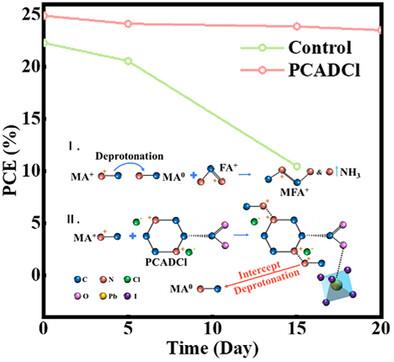Suppressing Deprotonation to Extend the Shelf Life of Perovskite Precursor Solutions and Enhance the Stability and Efficiency of Perovskite Solar Cells
IF 19
1区 材料科学
Q1 CHEMISTRY, MULTIDISCIPLINARY
引用次数: 0
Abstract
Amid the rapid advancement of formamidine (FA)-based perovskite solar cells (PSCs), methylammonium chloride (MACl) has emerged as a pivotal molecule, widely recognized in achieving high-efficiency PSCs. However, in perovskite precursor solution (PPS), particularly after prolonged storage, deprotonated MA⁺ (MA0) undergoes cationic addition with FA⁺, leading to a relative depletion of FA⁺ and a reduction in crystalline phase purity. Herein, using Piperazine-2-carboxylic acid dihydrochloride (PCADCl) to inhibit MA⁺ deprotonation by forming strong two-point hydrogen bonds between the piperazine's amine groups and proton (H⁺) of MA⁺is proposed, thereby extending the shelf life of the PPS. Furthermore, COOH groups of PCADCl furtherly suppress MA⁺ deprotonation while promoting coordination with unbound Pb2+, reducing film defects and improving the purity of the perovskite crystalline phase. Additionally, the energy level arrangement of the PSCs is improved. Benefiting from this strategy, the PSC fabricated with the modified PPS achieves an impressive efficiency of 25.56% and retains 96% of its initial performance after solution aging for 20 days. Moreover, the unencapsulated device retains 97% of its initial efficiency over 1300 h. This work significantly advances process development and scientific research, representing a crucial step toward the large-scale production and commercialization of PSCs.

抑制去质子化以延长钙钛矿前驱体溶液的保质期并提高钙钛矿太阳能电池的稳定性和效率
随着甲脒(FA)基钙钛矿太阳能电池(PSCs)的快速发展,甲基氯化铵(MACl)已成为实现高效钙钛矿太阳能电池的关键分子。然而,在钙钛矿前驱体溶液(PPS)中,特别是在长时间储存后,去质子化MA + (MA0)与FA +发生阳离子加成,导致FA +相对耗尽,晶相纯度降低。本文提出用哌嗪-2-羧酸二盐酸(PCADCl)抑制MA⁺的去质子化,通过在哌嗪的胺基与MA⁺的质子(H +)之间形成强两点氢键,从而延长PPS的保质期。此外,PCADCl的COOH基团进一步抑制了MA⁺的去质子化,同时促进了与未结合的Pb2+的配位,减少了薄膜缺陷,提高了钙钛矿晶相的纯度。此外,改进了PSCs的能级排列。得益于这一策略,用改性PPS制备的PSC在溶液老化20天后达到了令人印象深刻的25.56%的效率,并保持了96%的初始性能。此外,未封装的装置在1300小时内保持了97%的初始效率。这项工作显著推进了工艺开发和科学研究,代表了psc大规模生产和商业化的关键一步。
本文章由计算机程序翻译,如有差异,请以英文原文为准。
求助全文
约1分钟内获得全文
求助全文
来源期刊

Advanced Functional Materials
工程技术-材料科学:综合
CiteScore
29.50
自引率
4.20%
发文量
2086
审稿时长
2.1 months
期刊介绍:
Firmly established as a top-tier materials science journal, Advanced Functional Materials reports breakthrough research in all aspects of materials science, including nanotechnology, chemistry, physics, and biology every week.
Advanced Functional Materials is known for its rapid and fair peer review, quality content, and high impact, making it the first choice of the international materials science community.
 求助内容:
求助内容: 应助结果提醒方式:
应助结果提醒方式:


